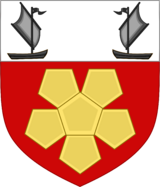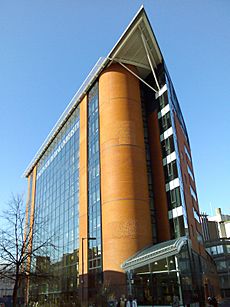London South Bank University facts for kids

|
|
|
Former names
|
Borough Polytechnic Institute (1892–1970), Polytechnic of the South Bank (1970–1987), South Bank Polytechnic (1987–1992) |
|---|---|
| Type | Public |
| Established | 1992 (university status) 30 September 1892 (Borough Polytechnic Institute) |
| Chancellor | Sir Simon Hughes |
| Vice-Chancellor | Paul Kett |
|
Administrative staff
|
1,700 |
| Students | (2015/16) |
| Undergraduates | (2015/16) |
| Postgraduates | (2015/16) |
| Location |
Southwark, London
,
England, United Kingdom
|
| Campus | Urban |
| Affiliations | EUA |
 |
|
London South Bank University (LSBU) is a public university located in Elephant and Castle, London. It is in the London Borough of Southwark, close to the South Bank of the River Thames. The university gets its name from this area.
LSBU started in 1892 as the Borough Polytechnic Institute. It became a university in 1992. In September 2003, it changed its name to London South Bank University. Since then, it has opened new centers like the School of Health and Social Care and Elephant Studios for media. The university has many students and about 1,700 staff members.
In November 2016, LSBU was named the Entrepreneurial University of the Year. This award recognized its focus on helping students develop business ideas. The university also received a Silver rating in the 2017 and 2023 Teaching Excellence Framework. This rating shows the quality of its teaching.
Contents
History
How LSBU Started
London South Bank University began as the Borough Polytechnic Institute in 1892. Over the years, its name changed several times. It became the Polytechnic of the South Bank in 1970, South Bank Polytechnic in 1987, and South Bank University in 1992. Finally, in 2003, it became London South Bank University. The university also grew by joining with other schools.
In 1888, a local lawyer named Edric Bayley helped create a committee to set up polytechnics in South London. Many important people, including the Lord Mayor of London, were part of this committee. They successfully raised money to build polytechnics in Battersea and at Borough Road, which is now LSBU.
The Borough Polytechnic Institute officially opened on September 30, 1892. Its goal was to teach practical skills to young men and women in the local community. The Polytechnic had a special seal and a motto that meant "Do it with all your strength."
Early Education and Growth
The Polytechnic offered courses that matched local jobs. These included leather tanning, printing, metalwork, and electrical engineering. They also taught art, science, and general knowledge. Famous speakers like George Bernard Shaw gave talks there.
In 1894, the National School of Bakery and Confectionery opened with 78 students. In 1908, the Edric Hall and other new buildings were added. These gave the Polytechnic more space for baking, a gym, and workshops.
During the First World War, the Polytechnic helped the war effort. It made things like munitions and gas masks. After the war, new engineering courses were offered to women in the 1920s. In 1930, the Duke of York officially opened the Polytechnic's new buildings. By 1927, the number of students had grown to 8,682.
World War II and Beyond
During the Second World War, parts of the Polytechnic were damaged by bombs. Even so, it continued to help the community by providing meals to people who lost their homes.
After the war, in 1945, the British painter David Bomberg taught art at the Polytechnic. In 1970, several other colleges joined the Polytechnic. These included the Brixton School of Building and the National College of Heating. This created the larger Polytechnic of the South Bank.
In 1972, a new building opened on Wandsworth Road. It housed the Faculty of the Built Environment, which taught subjects like surveying and architecture. In 1975, the large London Road building opened for business courses and the library.
In 1987, the Polytechnic changed its name to South Bank Polytechnic. In 1992, it became South Bank University after gaining university status. This was a big step, and the university celebrated its 100th birthday that year.
LSBU in the 21st Century
In 2003, the university changed its name to London South Bank University (LSBU). In 2009, a major new building called K2 opened. It houses the School of Health and Social Care and special labs for nursing students.
More new buildings followed, including a Student Centre in 2012 and an Enterprise Centre in 2013. In 2016, LSBU opened Elephant Studios, a new media center.
In 2014, LSBU helped open the University Academy of Engineering South Bank. This school in Walworth teaches students aged 11–19. Lambeth College is also planning to join with LSBU.
Campus
LSBU's main campus is in the London Borough of Southwark, just north of Elephant and Castle. The main entrance is on Borough Road, where the original building stands. London Road is to the west, and Southwark Bridge Road is to the east.
LSBU also has a smaller campus in east London, called LSBU at Havering. A new campus in central Croydon is set to open in September 2021.
Organisation
The university has seven main Schools:
- School of Applied Sciences
- School of Arts and Creative Industries
- School of the Built Environment and Architecture
- School of Business
- School of Engineering
- School of Health and Social Care
- School of Law and Social Sciences
Course Changes
In April 2021, the university announced that it would not be accepting new students for history or human geography courses that year.
Academic Profile
The British painter David Bomberg taught art at the Borough Polytechnic from 1945 to 1954. One of the university's student housing buildings, David Bomberg House, is named after him. Some of his paintings are displayed at the university.
London South Bank University works with schools and organizations around the world. It has strong connections with universities in China, offering joint study programs. In 2007, LSBU opened the first Confucius Institute for Traditional Chinese Medicine.
Rankings and Reputation
| National rankings | |
|---|---|
| Complete (2021) | 109 |
| Guardian (2021) | 59 |
| Times / Sunday Times (2021) | 100 |
| Global rankings | |
| QS (2021) |
901–950 |
| THE (2021) | 601–800 |
| British Government assessment | |
| Teaching Excellence Framework | Silver |
In November 2016, LSBU was named the Entrepreneurial University of the Year. This award came from the Times Higher Education Awards.
The Guardian's 2018 rankings placed LSBU 92nd out of 121 British universities for teaching quality. The Guardian also rated LSBU joint 13th for law students.
In the 2017 Teaching Excellence Framework, which rates the quality of university teaching, LSBU received a "Silver" ranking. It kept this rating in the 2023 assessment.
Who Studies at LSBU?
Most students at London South Bank University (70%) are from London. Many come from the South London areas of Southwark, Lambeth, Lewisham, and Croydon. About 12% of students are from other countries, coming from over 130 different nations. More than half of the students are from ethnic minorities, and over 80% are considered mature students (meaning they are 21 or older when they start their course).
Notable Alumni
- Sir David Adjaye, architect
- Wavinya Ndeti, politician
- Frank Auerbach, painter
- Shaun Bailey, politician
- Anton Balasingham, political strategist
- Sue Black, computer scientist
- Paul Burstow, former politician
- Mel Calman, cartoonist
- Edd China, television presenter and engineer
- June Clark, nurse
- Marsha de Cordova, politician
- Dennis Creffield, artist
- Cassiel Ato Forson, politician
- Faith Gibson, British nurse, academic, and researcher
- Cliff Holden, painter
- Edna Adan Ismail, former foreign minister of Somaliland
- Jordan Kensington
- Leon Kossoff (Art)
- Don Lawrence (Illustration)
- Nick Leslau (Surveying)
- Russel Lissack, musician
- Norma Major, philanthropist and wife of Sir John Major
- Shahid Malik, politician
- Kevin McGrath (Estate management)
- Sarah Mullally (Nursing)
- Bridget Prentice (Law)
- Yasmin Qureshi, Politician
- Bali Rai (Politics)
- Miles Richmond (Art)
- Joan Ryan, politician
- Patrik Schumacher, architect
- Greg Searle
- Enoch Showunmi (Business)
- Edward Skoyles
- Phil Spencer (Estate management)
- Mike Weatherley, politician
- Charlie Whiting
- Louise Woodward (Law)
See also
- Armorial of UK universities
- Borough Road Gallery, opened 2012
- List of universities in the UK
- Post-1992 university
Images for kids





